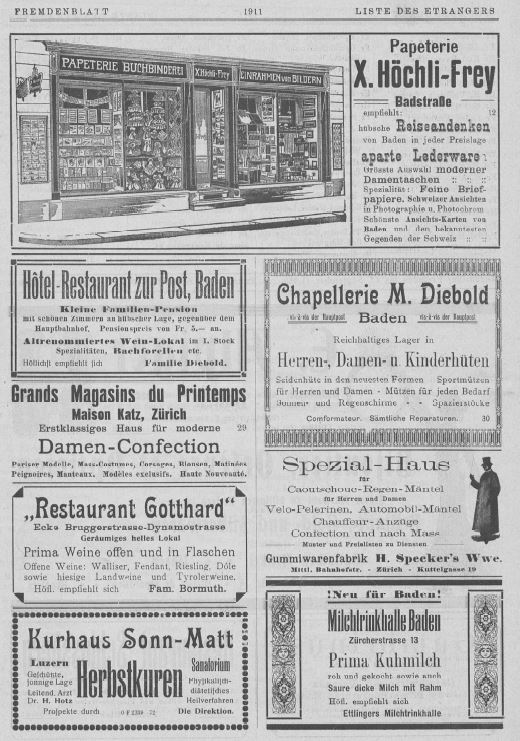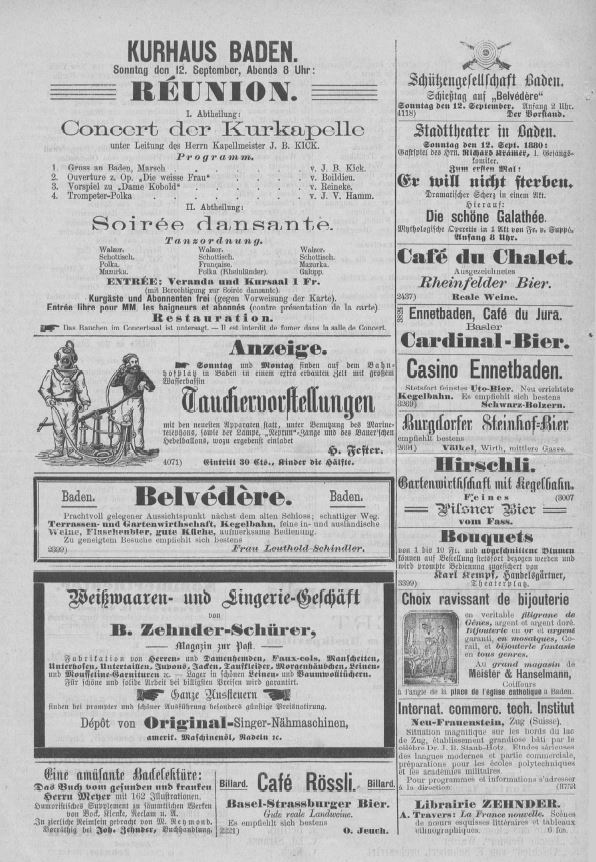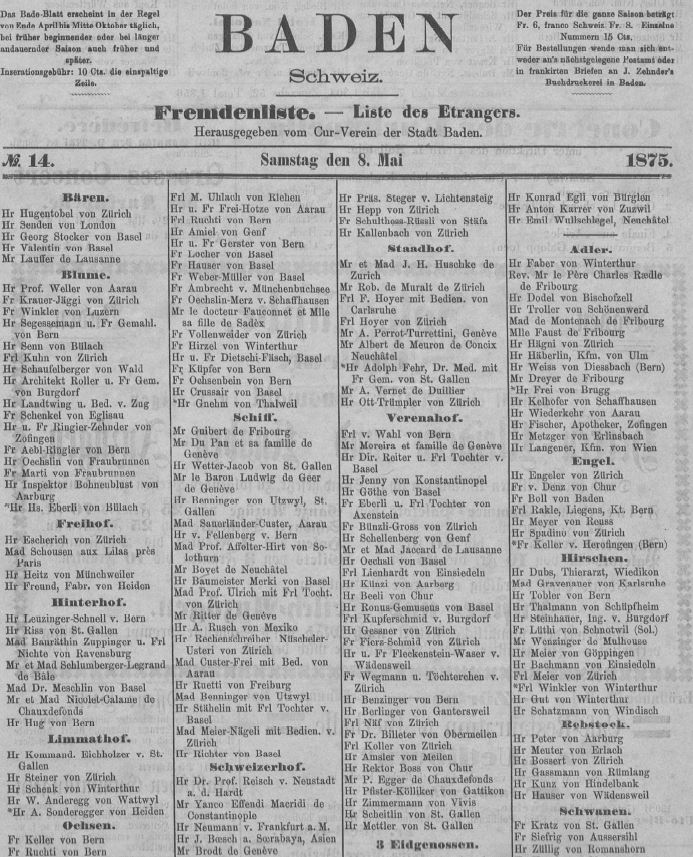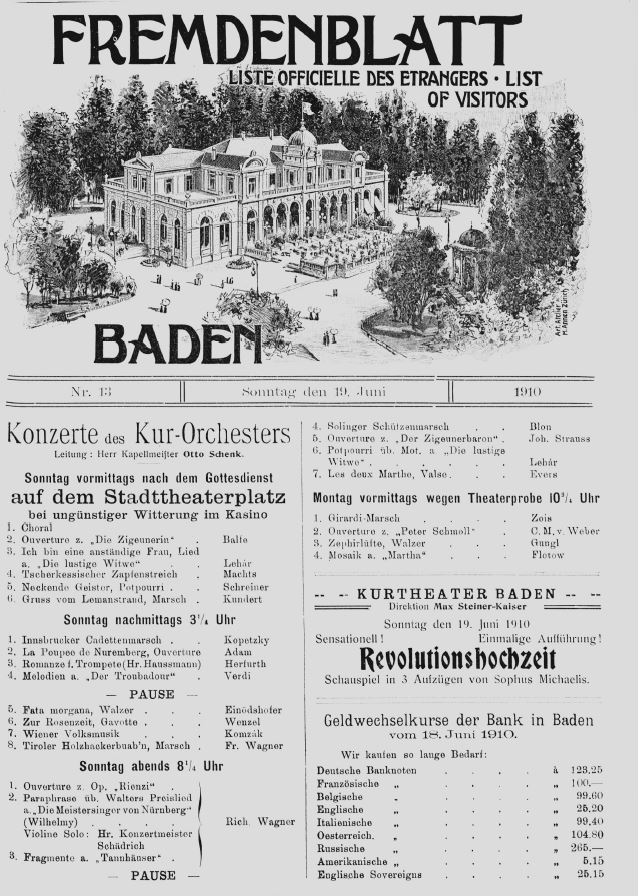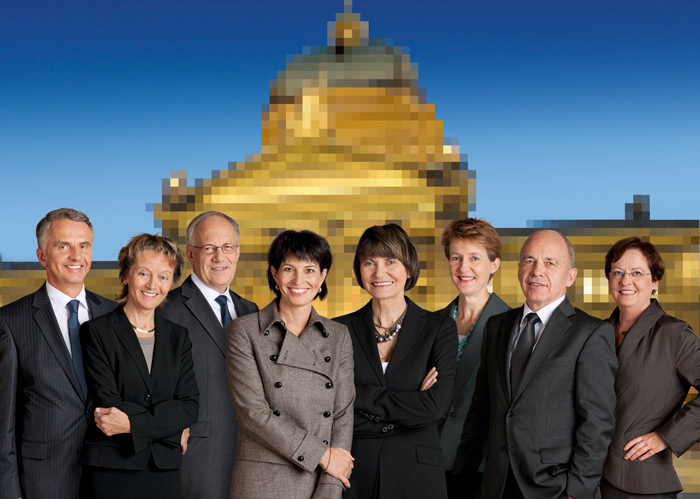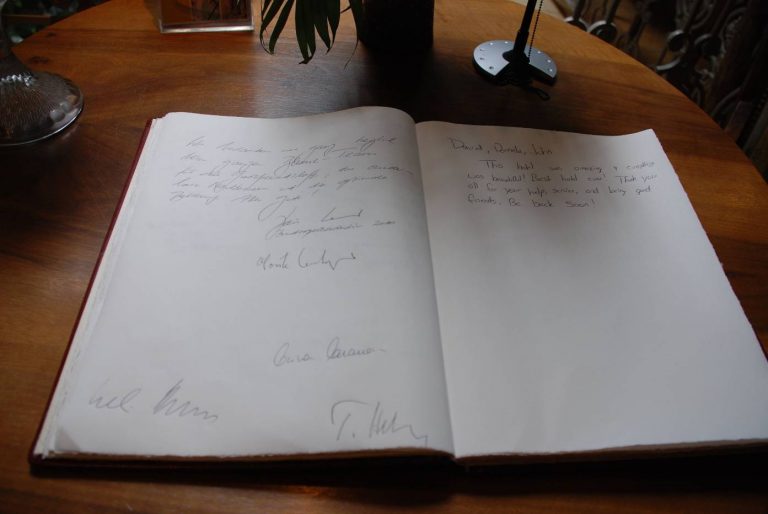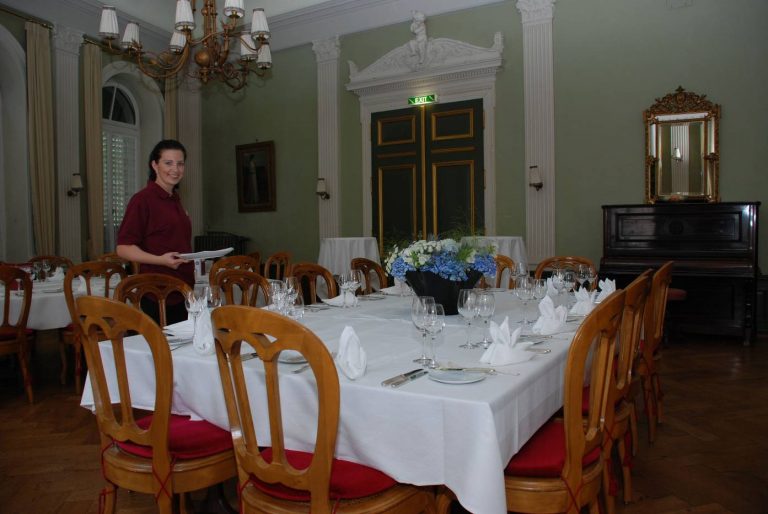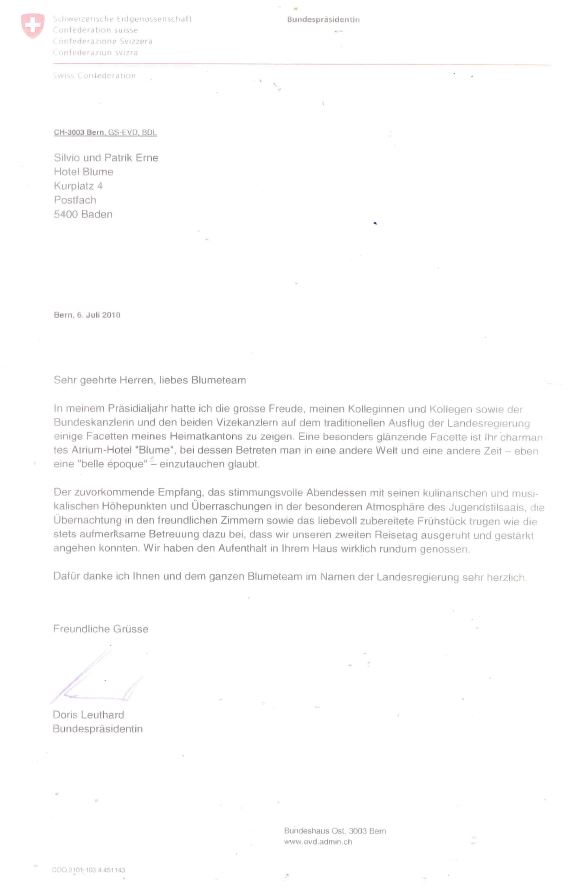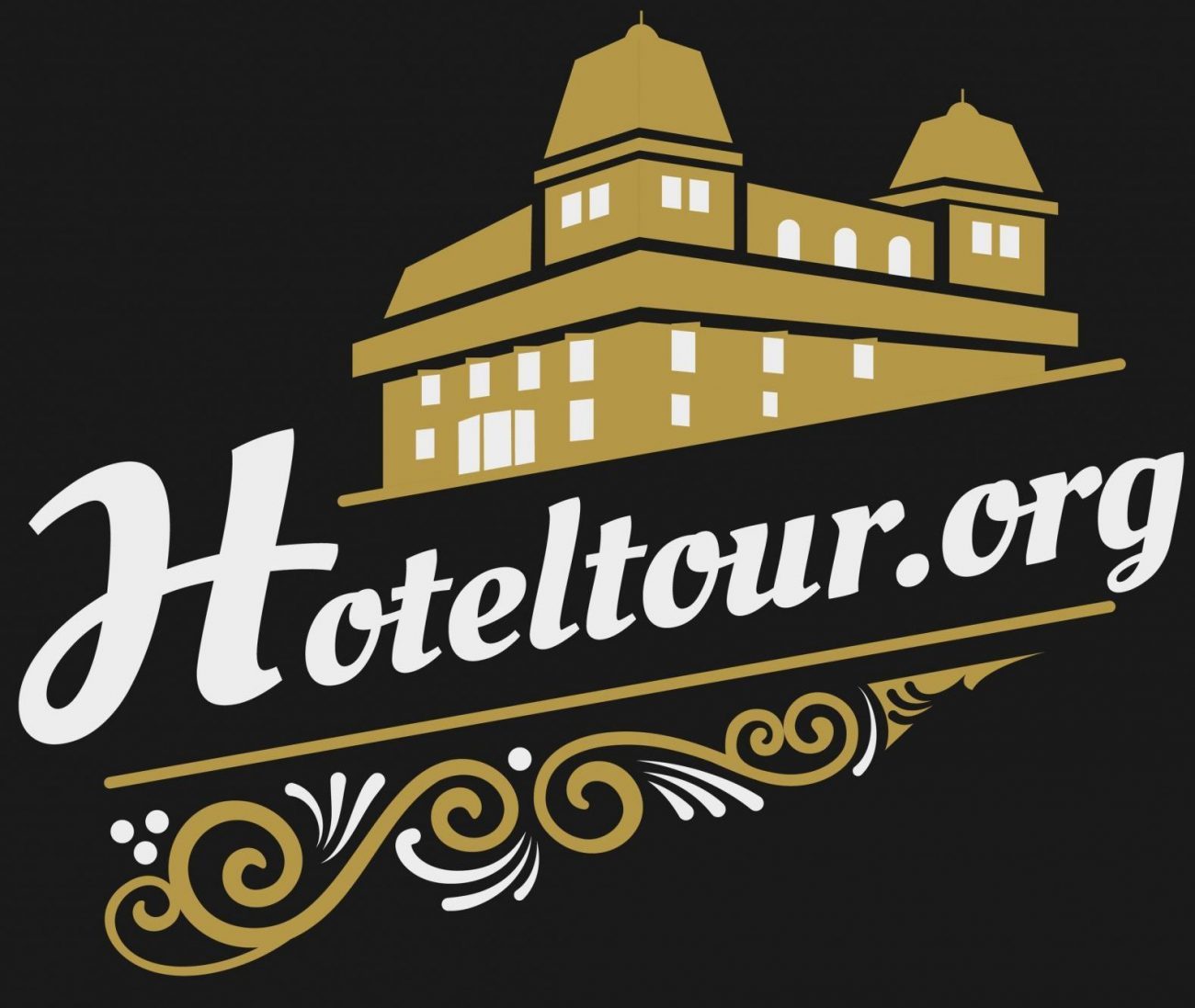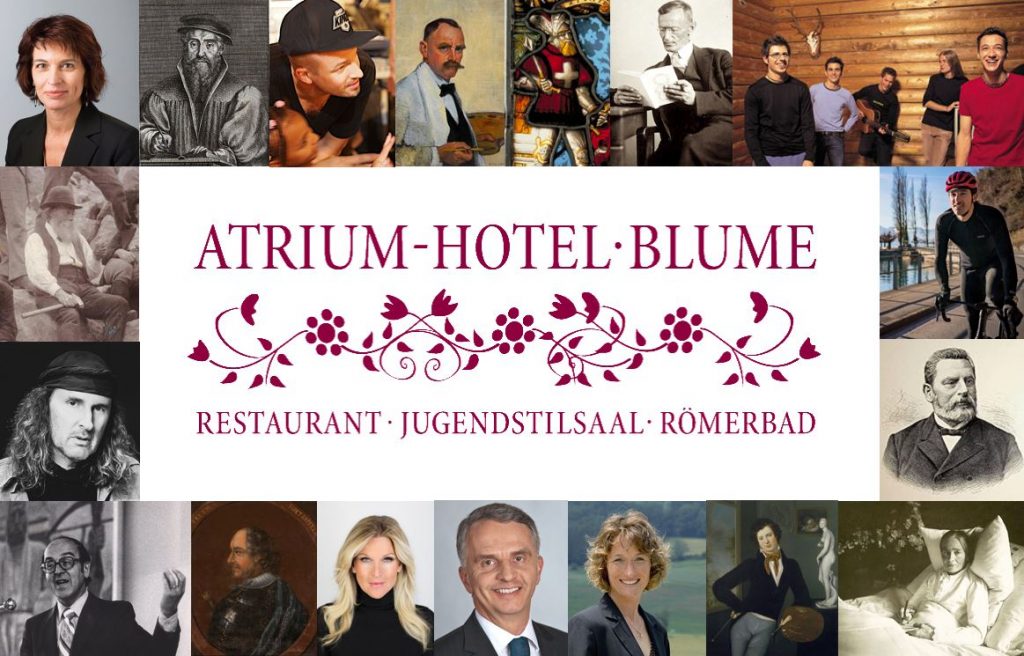
Knights, generals, politicians, painters, musicians, professors, federal councillors and more: famous guests at the Blume.
Most of the Blume visitors remain unknown. From 1830 onwards guests staying in Baden are systematically listed in the Baden Fremdenblätter. The big names descended in the more famous and also larger houses: In the Staad- and Hinterhof, later in the Verenahof and the Grand Hotel Baden.
More Information
Clockwise from top left:
Doris Leuthard, Merenschwand, Federal Councillor, 2010.
Heinrich Pantaleon, Basel, humanist scholar, 1570s.
Andres Andrekson, Stress, Lausanne, Swiss rapper.
Carl August Liner (self-portrait), painter, Appenzell, 1939.
Gotthard von Breiten-Landenberg (here a relative), knight, Brugg, 1526.
Hermann Hesse, Montagnola, writer, 20th century.
Plüsch, Interlaken, Swiss band.
Fabian Cancellara, Wohlen near Bern, cyclist, Olympic champion 2008.
Johann Jakob Hohl, Herisau, Council of States, 1910.
Dr. Marie Heim-Vögtlin, Zurich, first Swiss female doctor, 1911.
Moritz Daniel Oppenheim, Frankfurt, Jewish painter, 1875.
Susanne Hochuli, Reitnau, member of the government of the canton of Aargau, 2010.
Didier Burkhalter, Neuchâtel, Federal Council, 2010.
Patricia Boser, Zurich, radio presenter.
Peter Melander von Holzappel, Niederhadamar, commander, 1640s.
Kurt Furgler, St. Gallen, Federal Council.
Chris von Rohr, Solothurn, musician.
Heim, Albert, Zurich, Professor of Geology, 1907.
As the trendy bathing city of Europe, Baden has been attracting more and more guests since the 11th century. During the golden age of bathing, these included the participants of the councils of Constance and Basel, the Austrian dukes, who continued to visit Baden to take a cure even after their loss of power. They were joined by pilgrims, noblemen and citizens from southern Germany and Austria and from far away. In the 17th and especially in the 18th century, the bathing resort fell into a crisis, which was also reflected in the composition of the guests. Foreign guests were the minority. Only in the 19th century, with more medical knowledge and improved infrastructure, Baden became more important again in the network of European spas: the great era of bathing cures began. The bourgeoisie then used the annual spa cure as a temporary way of life, and until 1913 the number of overnight stays in Baden increased almost continuously. The symbiosis of spa life, newly emerging tourism and art led to a cultural flowering that still fascinates today.
From 1830 to the 1960s, all guests who stayed for a cure in the Blume and also in the other bathing hotels were on official guest lists. Today, the Fremdenblätter are stored in the Baden City Archive, where they are digitally accessible. The daily paper was both an information and communication tool, which was important for all those directly or indirectly affected by tourism. It has changed over time, as the change of name shows: from Badeblatt to Fremdenliste, Baden bei Zürich, Switzerland.
The Swiss Federal Council traditionally undertakes an annual excursion to the home canton of one of its members «- the Bundesratsreisli» (translates as the small trip of the council)
In 2010, the councils visited the canton of Aargau, the home canton of the then Federal Councillor and President of the Swiss Confederation Doris Leuthard. The fact that the Hotel Blume was chosen for overnight accommodation, dinner and breakfast shows the importance of the only «historic hotel» in the canton. Until shortly before the arrival nobody was allowed to know about the high level visit except the managing directors and the chef. The Federal Council menu for dinner was quite respectable:
Appetizer
Carpaccio of Aargauer water buffalo with Sbrinz and rocket
Soup
Corn cream soup with strips of Mägenwiler range poulard breast and saffron
Main course
Fillet medallions of Agri-Natura veal and Natura Beef on young leaf spinach with balsamic hollandaise and rosemary potatoes;
(for the vegetarian Moritz Leuenberger there was fish filet from the Hallwil lake)
Dessert
Tarte Tatin with Aargauer apples and peach flavoured frozen yoghurt
Wines
Aargauer Fumé Blanc from several growing areas and Wettinger Blauburgunder
The Federal Councillors also spent the night and had breakfast at the Blume. They ate in a separate room but still got their food from the buffet along with the other hotel guests.
Albert Heim came for a cure in 1907 at the Blume of Baden. The ETH professor of geology did research in the field of ductile deformation of rocks and described folds of all sizes. He also worked in glaciology and created panoramas and reliefs. In 1898 he undertook the first scientific balloon flight over the Alps with Eduard Spelterini.
His wife was even more famous than he was. Marie Vögtlin-Heim was a guest at the Blume in 1911. After school, she wanted to study medicine and her decision caused public outrage. In vain: In 1868, she was the first Swiss woman at the medical faculty of the University of Zurich. She later worked in Leipzig and Dresden and received her doctorate in 1874, after which she became the first Swiss doctor to open a gynaecology practice in Zurich. After the birth of her three children, she continued to work. She was always aware of her role as a pioneer. She sympathized with the women’s movement and promoted health awareness through lectures and publications. Marie Vögtlin-Heim suffered from tuberculosis and died in 1916, five years after staying at the Blume.
Moritz Daniel Oppenheim (1800-1882) was a German portrait and History painter. He is considered the first Jewish painter to achieve worldwide fame. He stayed at the Blume in 1875.
In a letter dated July 19, 1830, Konrad Mäder reports on his spa treatment at the Blume. (The transcription of the letter is still pending).
Clockwise from top left:
Doris Leuthard, Merenschwand, Federal Councillor, 2010. (Wikipedia)
Heinrich Pantaleon, Basel, humanist scholar, 1570s. (Wikipedia)
Andres Andrekson, Stress, Lausanne, Swiss rapper. (Wikipedia)
Carl August Liner (self-portrait), painter, Appenzell, 1939. (Wikipedia)
Gotthard von Breiten-Landenberg (here a relative), knight, Brugg, 1526. (Schweizerisches Nationalmuseum, LM-6184)
Hermann Hesse, Montagnola, writer, 20th century. (Wikipedia)
Plüsch, Interlaken, Swiss band. (www.discogs.com)
Fabian Cancellara, Wohlen near Bern, cyclist, Olympic champion 2008. (Wikipedia)
Johann Jakob Hohl, Herisau, Council of States, 1910. (www.zvab.com)
Dr. Marie Heim-Vögtlin, Zurich, first Swiss female doctor, 1911. (Wikipedia)
Moritz Daniel Oppenheim, Frankfurt, Jewish painter, 1875. (Wikipedia)
Susanne Hochuli, Reitnau, member of the government of the canton of Aargau, 2010. (Wikipedia)
Didier Burkhalter, Neuchâtel, Federal Council, 2010. (Wikipedia)
Patricia Boser, Zurich, radio presenter. (patriciaboser.ch)
Peter Melander von Holzappel, Niederhadamar, commander, 1640s. (Wikipedia)
Kurt Furgler, St. Gallen, Federal Council. (Wikipedia)
Chris von Rohr, Solothurn, musician. (Wikipedia)
Heim, Albert, Zurich, Professor of Geology, 1907. (Wikipedia)
Badener Fremdenblätter, available in the Baden City Archives
Müller, Florian: Das vergessene Grand Hotel. Leben und Sterben des grössten Badener Hotels, 1876-1944, Baden, 2016.
More illustrations
